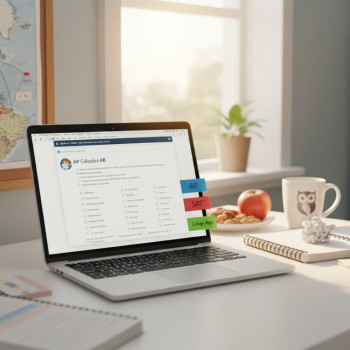Introduction: Why this guide is for you
Being an exchange student is an adventure — new friends, new classes, new routines, and a fresh perspective on life. Adding SAT preparation to that mix can feel like trying to study while your world is still spinning. If you’re balancing travel paperwork, cultural adjustments, and a different schooling system, you want guidance that’s practical, efficient, and respectful of your time. This guide walks you through exactly what matters for the Digital SAT: how to register, what the test looks like now, how to structure study time, what to do the week before the test, and how to manage language and cultural differences without losing momentum.
Quick snapshot: The Digital SAT and what to expect
Before diving into a study plan, it helps to know the terrain. The SAT moved to a digital format with a few changes that actually benefit many students: shorter overall test time, more time per question on average, a built-in calculator for the whole math section, and the Bluebook testing app used on approved devices. For exchange students, this digital shift is mostly a good thing — but it also introduces practical steps (like device readiness and app setup) you must complete before test day.
Key things to know right away
- The Digital SAT runs on approved devices using the Bluebook app; you must install and test the app beforehand.
- Registration and test-center availability differ by location and date — plan early.
- Scores are reported online; timelines generally fall within a few weeks after test day.
- Testing rules, accommodations, and fee structures may vary for international test-takers — check those details as early as possible.
Step 1 — Register smart: timing, fees, and documents
Registration is where you convert intention into a firm plan. For exchange students, this step has an extra layer: you may need to coordinate with your host school, verify personal information, and ensure your identification documents meet test-center requirements.
When to register
Pick a test date that gives you at least 8–12 weeks of focused prep if you’re aiming for a meaningful score increase. If you’re already comfortable with the test format (for example, if you’ve taken a practice Digital SAT or PSAT recently), 6–8 weeks can be sufficient for a targeted push. If English is your second language and you want higher scores in Evidence-Based Reading and Writing, give yourself 12+ weeks to build reading habits and vocabulary in context.
What you’ll need to sign up
- A College Board account (create one early and save the login somewhere secure).
- Valid photo ID that the test center will accept — rules can vary by country, so verify the acceptable forms of ID for your test location.
- Payment method for registration fees and any optional services (like extra score reports).
- Time to choose your preferred test center and to confirm device availability if the center requires you to use their machines.
Step 2 — Get comfortable with the digital environment
One of the most anxiety-inducing uncertainties for exchange students is the digital testing setup. You might be using your own laptop, a school-managed Chromebook, or a device provided by the test center. Whatever it is, practice on the same kind of device with the Bluebook app installed.
Device checklist
- Confirm that your device model and operating system are approved for use with the Bluebook app.
- Install Bluebook early and complete the setup tasks it asks for; some steps must be finished before exam day.
- If you need to borrow a device, arrange that weeks ahead — device lending options exist but can require administrative steps.
- Practice typing, using the on-screen tools, and navigating between questions so the interface feels normal on test day.
Step 3 — Build a study plan that fits your life
As an exchange student your schedule might be less predictable than that of your local peers. That’s fine — your study plan should be flexible, efficient, and focused on high-yield activities.
How to structure your weekly prep
Here’s a simple rhythm that most students find effective. Aim for consistency rather than marathon sessions:
- 3–4 focused practice sessions per week, 60–90 minutes each.
- 1 full-length Digital SAT practice test every 2–3 weeks (use the Bluebook practice tool to mirror test conditions).
- Daily micro-practice: 10–20 minutes of vocabulary in context, quick math drills, or one reading passage.
Prioritize by score impact
Not all study tasks are equal. Use your baseline diagnostic (a practice test) to identify high-impact weaknesses. If your score shows a small reading deficit but larger gaps in algebra or problem-solving, prioritize math review. If timing is an issue, practice under timed conditions and work on pacing strategies.
Step 4 — Content strategies: reading, writing, and math
Below, practical tactics for each section, with simple, repeatable exercises you can do anywhere — helpful for students on exchange programs who might be commuting or have unpredictable days.
Reading: study real texts, not isolated words
For many exchange students, vocabulary and cultural references are the trickiest pieces. But the SAT rewards context and reasoning more than memorized words.
- Read a variety of short, high-quality texts: op-eds, science summaries, short historical essays. Aim for sources that use precise language rather than slang.
- Practice annotating: one-sentence summary, the main author stance, and two supporting details. This habit translates directly to better question accuracy.
- Group practice: work with a classmate or host-family member — read a passage aloud and discuss the central point to simulate the cognitive processing needed for the SAT.
Writing & Language: choices and evidence
Focus less on obscure grammar rules and more on clarity, concision, and evidence use. Many questions are about choosing the sentence or paragraph that best supports the passage’s purpose.
- When you see a grammar question, read the sentence in context — the right answer often depends on tone and flow.
- Practice rewriting sentences to be clearer; concise sentences often win on the SAT.
Math: strategy, not speed
The Digital SAT’s math section allows a calculator for the entire portion, so emphasis shifts toward understanding concepts and setting up problems rather than mechanical arithmetic.
- Master the core topics: linear equations, systems, ratios, basic geometry, and functions. These appear repeatedly.
- Learn to estimate and eliminate answers — sometimes a rough check reveals the correct response faster than full computation.
- Practice with digital tools (your calculator and on-screen notation tools) so these are second nature on test day.
Step 5 — Use practice tests to shape your progress
Practice tests are diagnostic tools. Take them like exams occasionally, but more often use them to identify patterns: types of questions you miss, pacing problems, or mental fatigue.
How to analyze a practice test
- Score the test and record your section-level performance.
- Tag every wrong answer with a short label: careless, vocabulary, unfamiliar content, pacing, or calculation error.
- Create a weekly drill list from those tags — for example, if many wrong answers are “pacing,” include timed mini-sections in next week’s practice.
Step 6 — Test-day logistics and mental prep
Little logistical slips cause big stress. Take care of them early so you can focus on performance on test day.
Checklist for the week before
- Confirm your test center location, reporting time, and ID requirements.
- Open and test the Bluebook app on your device at least one full day before the test.
- Pack the night before: device (fully charged), approved chargers, photo ID, comfortable clothing layers, and a small snack if permitted.
- Practice a 20–30 minute relaxed routine to calm your mind — light review, breathing exercises, and a short walk help reduce pre-test anxiety.
On the morning of the test
Eat a balanced breakfast, arrive early, and avoid last-minute cramming that increases stress. Use the built-in tutorial in Bluebook to warm up if available.
Special considerations for exchange students
Exchange students face unique hurdles — language, unfamiliar procedures, and sometimes disruption from travel or visa paperwork. Here are practical solutions that fit into an exchange lifestyle.
Language differences and cultural references
- Build reading stamina with subject matter that interests you: science, sports analytics, or historical narratives help you absorb vocabulary naturally.
- Discuss practice passages with friends or tutors. Explaining an argument or passage in your own words is the most reliable way to internalize comprehension strategies.
Dealing with time away or travel
If you’ll be traveling close to test date (home visits, visas, or family trips), shift your practice earlier so major tasks are done before absences. Keep short drills (20 minutes) to maintain momentum while on the move.
Identification and administrative hurdles
Different countries and testing centers accept varying forms of ID. Confirm this early. If your passport is the only accepted form, make sure it’s valid for the entire admissions timeline you’re considering.
How personalized tutoring can fit into your plan
Not every student needs tutoring, but many exchange students benefit from targeted, individualized support — especially when juggling language growth and cultural acclimation. A service like Sparkl’s personalized tutoring can provide 1-on-1 guidance, tailored study plans, expert tutors familiar with Digital SAT specifics, and AI-driven insights to focus your practice efficiently. If you choose tutoring, look for short-term, goal-oriented packages: a diagnostic, a focused study plan, a series of targeted sessions, and frequent practice test reviews.
What good tutoring does for exchange students
- Speaks your academic language: tutors who can explain subtle grammar, phrasing, and argument structure clearly and patiently.
- Customizes practice: targeting exactly the question types and skills you miss most.
- Provides accountability: realistic milestones and daily/weekly check-ins that fit a variable schedule.
Practical study schedule example (10-week plan)
Below is a sample 10-week plan that balances academic improvement with the busy life of an exchange student. Adjust the weeks according to how much time you have before your chosen test date.
| Week | Main Focus | Weekly Activities |
|---|---|---|
| 1 | Diagnostic & familiarization | Full practice test (Bluebook), device check, identify top 3 weaknesses |
| 2 | Foundations | Target weak areas: basic algebra, reading passages, grammar rules; 3 sessions + daily micro-practice |
| 3 | Practice under timed conditions | 2 sections timed + review mistakes; vocabulary in context daily |
| 4 | Strategy work | Pacing strategies, calculator use, eliminating wrong choices; session with tutor if possible |
| 5 | Full practice test | Full Bluebook test; deep error analysis and drill list creation |
| 6 | Targeted drilling | Drill top 3 error types; timed mini-sections; reading comprehension practice |
| 7 | Fine-tuning | Work on stamina, trick questions, and time management; small-group review or tutoring |
| 8 | Practice test & review | Full test; review patterns; reduce new material and focus on consistent performance |
| 9 | Polish and relaxation strategies | Light review, practice calming routines, and checklist finalization |
| 10 | Test week | Short reviews only, confirm logistics, rest and sleep |
Common pitfalls and how to avoid them
Knowing what typically goes wrong helps you avoid the same mistakes.
Pitfall: Relying only on passive review
Reading summaries or watching videos feels productive but rarely moves the score needle. Active practice — answering questions, analyzing mistakes, and timing sections — is where real improvement happens.
Pitfall: Ignoring device setup
No matter how confident you are in your content knowledge, a technical hiccup with the Bluebook app or your device can derail your score. Install, test, and re-test early.
Pitfall: Trying to “cram” vocabulary lists
Vocabulary grows when you encounter words in sentences and arguments. Use vocabulary in context through reading and active summarizing rather than memorizing isolated lists.
Final thoughts: Make progress, not perfection
Preparing for the SAT while you’re an exchange student asks you to manage more variables than many peers. But being an exchange student also gives you strengths: adaptability, linguistic insight, and unique perspectives that can actually improve your reading and reasoning skills. Use a realistic study plan, practice in the same digital environment as the test, and consider short bursts of targeted tutoring — for example, Sparkl’s personalized tutoring — if you want focused 1-on-1 guidance, tailored study plans, and AI-driven insights to make your practice time count.
Remember: the SAT is one snapshot of your academic readiness. The work you do preparing — learning to analyze an argument, to solve a tough problem, to organize your thoughts under pressure — will pay off well beyond one score report. Take manageable steps, use high-quality practice tests, and treat the test as a challenge you can prepare for rather than an obstacle you must overcome alone.
Quick reference checklist — 2 weeks before the test
- Confirm ID and test center policies.
- Complete Bluebook setup and device checks.
- Take one lighter practice test and focus on calming routines.
- Pack your bag the night before with all essentials and arrive early.
Good luck — and remember that thoughtful, consistent preparation beats last-minute effort. You’ve already taken a big step by planning your path as an exchange student: keep going, one smart session at a time.













No Comments
Leave a comment Cancel